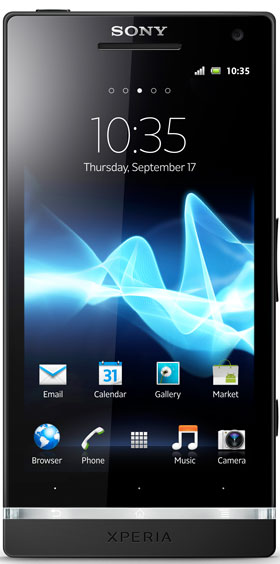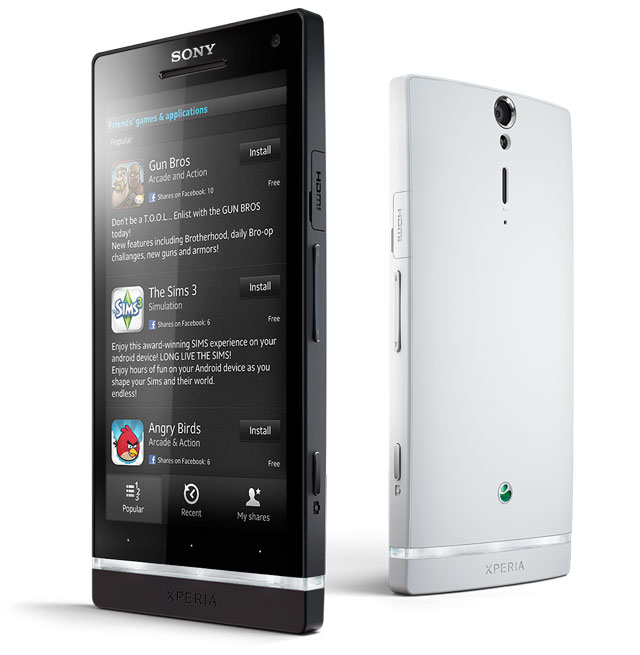 Having shed its partnership with Ericsson, Japan’s Sony is still trying to find its feet in the Android handset market. Despite marketing capabilities to rival Samsung’s, Sony hasn’t managed to cement itself a place in the smartphone war. The Xperia S looks unlikely to change that.
Having shed its partnership with Ericsson, Japan’s Sony is still trying to find its feet in the Android handset market. Despite marketing capabilities to rival Samsung’s, Sony hasn’t managed to cement itself a place in the smartphone war. The Xperia S looks unlikely to change that.
The top-end Xperia is a valiant attempt by Sony at regaining smartphone turf, but despite only a few months on the market — and thanks to its competitors’ recent offerings — it already feels dated.
Its hardware is right up there with its nearest rivals. Although it lacks the quad-core processors found on Samsung and HTC’s latest top-end offerings, it nevertheless offers a speedy dual-core, 1,5GHz Scorpion processor alongside 1GB of RAM and a Qualcomm Adreno 220 graphics processing unit.
The screen is no slouch, either. The LED-backlit LCD is a 4,3-inch, 1280×720-pixel capacitive multi-touch screen that offers a pixel density of roughly 342ppi — that’s higher than the iPhone 4S, HTC One X or Samsung Galaxy S3.
Thanks to its heritage in making Cyber-shot compact cameras, Sony has plenty of experience making camera optics — and the Xperia S benefits from this. Its 12-megapixel shooter includes an LED flash, records 1080p video at 30 frames per second and has a couple of nifty auto-panorama shooting modes and a two-step — focus and capture — dedicated camera button on the right-hand side of the handset.
Aside from its enormous resolution, the camera offers a great deal of control over settings, support for geo-tagging, touch focus, smile and face detection — with the former working some of the time — as well as image stabilisation in both stills and video mode. The flash can also be used as a video light.
Even the Xperia S’s front-facing camera is more respectable than many competitors’ offerings — it’s a 1,3-megapixel affair that also shoots 720p video at 30fps. If you’re the sort who bases their phone purchases on the quality of the camera, the Xperia S offers one of the best on the market — it’s a pity, then, that Sony got so much else about the handset wrong.
For starters, there’s the curious design decision regarding the back, home and options button beneath the screen. The logos for the three buttons are encased in translucent perspex that looks like it should be capacitive itself. It isn’t.
Instead, the buttons it refers to are actually three white dots beneath the display and it takes some time before one gets used to not pressing the perspex. After extended use, muscle memory kicks in and it becomes a design curiosity, but that doesn’t help overcome the software shortcomings.
The latest version of the Android operating system, called Ice Cream Sandwich, first appeared on the Samsung Galaxy Nexus in December. Why, then, is the Xperia S still running the older Gingerbread? The answer, no doubt, is because Sony has to update its Android overlay — which it calls Timescape — to accommodate the changes between versions of the operating system.
We’ve never cared much for Timescape — it’s more cumbersome and intrusive than Samsung’s TouchWiz and far less elegantly styled than HTC’s Sense — so we’d just as well do without it if we could have a later version of Android instead.

Supposedly, the Ice Cream Sandwich update for the Xperia S is coming this month or next, but with a slew of new devices hitting the market with the new software out of the box, having to wait for an update makes the Sony a far less compelling prospect.
Then there’s the issue of the battery. Though it’s rated for 1 750mAh, like most smartphones you’ll be lucky to get a full working day’s life out of it. But that’s not our gripe — the gripe is that it’s built in. Sure, unibody phones are increasingly common, but so too is putting a Sim-card slot on the side of the device in such instances. Instead, Sony has opted for a plastic rear cover that does nothing other than allow access to the Sim-card holder and increase the likelihood of the cover getting destroyed if the phone were, say, to be accidentally hurled across an office. [Reading this makes me nervous – Ed.]
Despite the removable rear cover, there’s no option for expanding the onboard memory via microSD cards. Granted, there’s 32GB of onboard flash memory, but it’s always nice to have the option and it’s something many Android users have come to expect from handsets.
For a company that can afford some of the best industrial designers in the world, the Xperia S is by no means the best designed mobile phone on the market. It’s not even the best-designed phone in the TechCentral office.
The Xperia S does, however, redeem itself somewhat when it comes to the price. At R5 299, it’s one of the cheapest high-end handsets we’ve seen this year. Moreover, it’s cheaper than its nearest competitors.
From a functionality perspective, once the Ice Cream Sandwich update is available, the Xperia S will be a capable and cost-saving competitor to the best and brightest the smartphone world has to offer. The problem is that by the time that happens most people will have already bought one of the best and brightest from one of Sony’s rivals. — (c) 2012 NewsCentral Media

